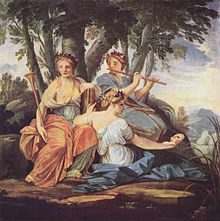Aedea
In Greek mythology Aedea or Aede (in Greek Αοιδη, Aoide, "to sing"), is the third and last of the original muses (according to Pausanias), along with her sisters Mnemea and Meletea.
Aedea is the muse of the execution of the artistic work; she is the one of the staging as such, since it is she who is in charge of reading, reciting, playing (instruments) or singing what her sister Mneme has previously written. She represents the moment in which a work of art is used.
On the other hand, it is thought that the artistic work only has a life of its own while the artist was creating it (painting a picture, writing a song, etc.), but this work did not correspond to Aedea, but to her sister Mnemea. Once the work was created, it 'dies' in a certain sense, as it becomes static and undergoes no further changes. As the culmination of the work, only its reproduction or execution of said work remains, a work that corresponded to Aedea.
Iconographically, she is represented as a young woman in an attitude of singing or reciting poems, while playing a lyre, because it is considered that the sound of musical instruments is like a simile of a voice.
Contenido relacionado
Proto-Indo-European religion
Charybdis
Brontes
